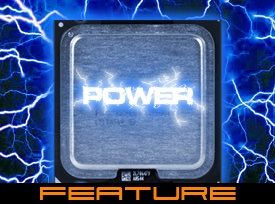Does Saving Power Mean Hurting Performance?

Is the Price For Efficiency Acceptable?
It seems like everyone in the tech industry recently jumped on the same bandwagon. Whether they call it green computing or the quest for efficiency, the end goal is the same: to decrease power requirements in all PC-component categories and to focus on performance per watt rather than all-out horsepower. Obviously, value takes on a new meaning in such a context, but performance remains a key focus. So, we wanted to dive deeper into the performance impact of power-saving technologies on today’s processors and motherboards.

The Power Consumption Issue
The discussion about power consumption and power efficiency isn’t new, but it has become a central issue among hardware manufacturers, due in part to increasing energy costs. The point of contention is that because PC components utilize different amounts of power when they’re active or idle, we believe that a component should only utilize as much power as required to do its work.
History Of Coverage With A Focus On Power And Efficiency
Tom’s Hardware was one of the first publications to criticize excessive power consumption across multiple hardware components and to talk about more efficient computing options. The focus has historically centered on processors, since they're often the most power-hungry devices inside a PC. This has changed a lot in recent years, as upper-mainstream and high-end graphics cards tend to be the power hogs today.
Coverage milestones :
- Intel’s 3.6 GHz Pentium 4 560 processor could throttle clock speed at peak power due to its high-power requirements and resulting high-core temperatures : The P4-580’s Heat Can Crash And Kill (November 2004). Things improved with the Pentium 4 570, though.
- Quick and Quiet : Pentium M Desktop Boards by AOpen and DFI (December 2004)
- AOpen Powermaster Power-Saving Solutions (April 2005)
- We compared idle and peak power consumption of all popular platforms as early as in 2005, when no one else really cared about it: The AMD and Intel Energy Crisis (July 2005)
- Dual-Core Processors for Low-Power, High-Performance Desktops (April 2006)
- Green Machine: AMD Dual-Core Platform at 54 W (September 2006)
Power Savings Work. What’s Next ?
Stay on the Cutting Edge
Join the experts who read Tom's Hardware for the inside track on enthusiast PC tech news — and have for over 25 years. We'll send breaking news and in-depth reviews of CPUs, GPUs, AI, maker hardware and more straight to your inbox.
With more manufacturers becoming aware of the new market requirements, components increasingly consume less power while delivering more performance than their predecessors. One of the best examples has been Intel’s Core 2 Duo, which consumes half the power as a Pentium D dual core (don’t confuse it with the Pentium Dual Core, which is based on the Core 2 family) while delivering much more performance. Other examples can be found in the storage segment, where WD’s latest Green drive outperforms many conventional drives.
While there are limits to power savings, which are defined by the technology used, we expect efficiency to keep increasing. This means that the power consumption of mainstream components should continue to decrease or stay at today’s levels, while performance will continue to improve. Combining lower power and more performance also significantly boosts efficiency. Let’s look at the two ways processor power consumption can be improved before comparing some benchmark results of systems with various popular power-saving settings versus system running at full tilt.
Current page: Is the Price For Efficiency Acceptable?
Next Page Technology And Features To Reduce Power ConsumptionMost Popular

